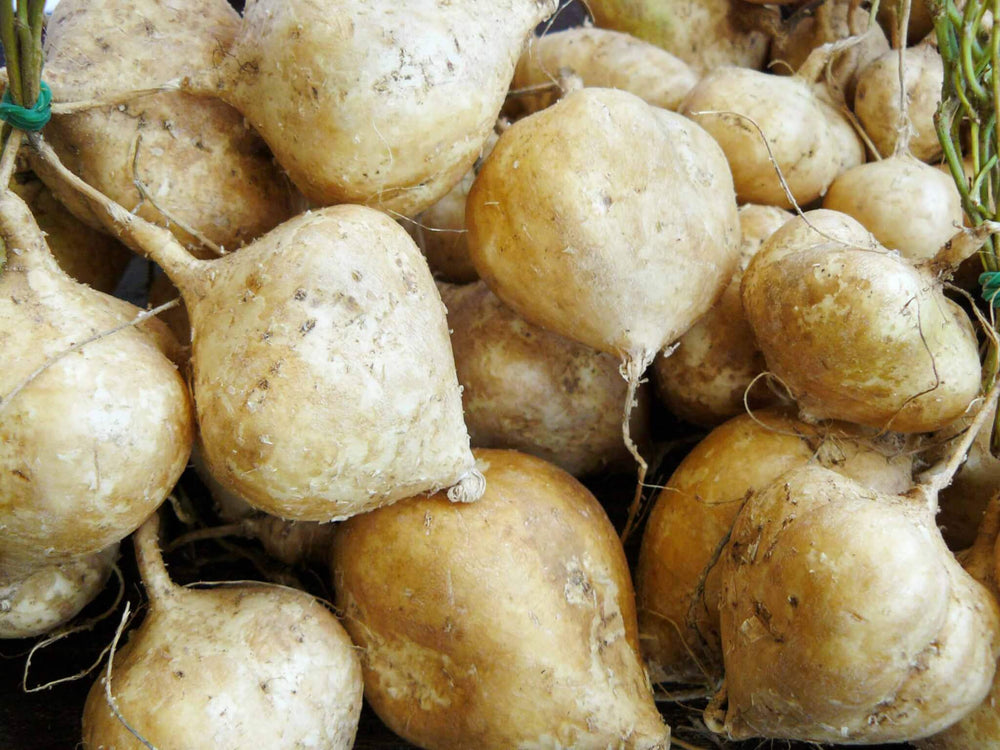Jicama is a root vegetable, traditionally grown in Mexico and Central America where it is native. Enjoy jicama (pronounced HEE kah mah or hee KAH mah) raw or cooked. It adds delicate sweetness and crunch to salads and stir-fries, but not many calories, making it a darling of health conscious gardeners and cooks.
Produced on a vigorous vine growing up to 15 feet long, jicama (Pachyrhizus erosus) needs a trellis, but it can do dual duty to shade an arbor, porch, greenhouse, or shed through a long, hot summer. Growing jicama requires time, as a long growing season is needed to produce the tasty underground tubers that are dug in fall.
Note: While we do not currently carry this variety, we offer this information for gardeners who wish to grow it.
Quick Guide to Growing Jicama
- Plant jicama in an area with full sun and a sturdy trellis to climb.
- Space jicama plants 12 inches apart in warm soil that is well-drained and full of nutrients.
- Improve native soil by mixing in several inches of aged compost or other rich organic matter.
- Jicama grows quickly, so keep soil moist and feed regularly with a continuous-release plant food.
- Harvest jicama approximately 150 days after planting—this should be right before the first frost.
Soil, Planting, and Care
To give the jicama plant what it needs, choose a location in full sun where there is support for the growing vine. Start by setting transplants as soon as the weather and soil have warmed.
Space plants 12 inches apart. You will probably get 4 to 5 roots per plant, so use that as a guide to determine how much to plant, based on the size of your family and their appetite for jicama.
Jicama grows best in moist, but well-drained soil. For excellent results, amend your native soil with a few inches of Miracle-Gro® Performance Organics® All Purpose In-Ground Soil before planting. Jicama is a vigorous grower that needs good nutrition, particularly potassium for the edible roots. Miracle-Gro® Performance Organics® Edibles Plant Nutrition Granules will provide all the nutrients this plant needs, so feed regularly during the growing season (be sure to follow the label directions).
Because the above-ground portions of the plant, including leaves, flowers, and seeds, are poisonous, pests do not eat the vine. Little pest control is needed.
You can also grow jicama in a large container if you do not have room in the garden or wish to take advantage of the vine as an ornamental plant.
Troubleshooting
Be careful not to eat flowers, seeds, or leaves, as they are poisonous. Few insect pests bother the vine.
Harvest and Storage
Dig the underground tubers as late as possible before frost nips the vine, preferably 150 days or more from the time you transplanted. That will give the roots time to grow large enough to dig and eat. If you see the vine beginning to die down, go ahead and dig.
Use care not to injure the root while digging. You will find them 3 to 6 inches in diameter. Let the soil dry and dust them off with a soft brush. Wash them when you are ready to eat.
Storage can be tricky. Jicama does not tolerate temperatures below 50 degrees without damage. That means that some refrigerators will damage the roots. The ideal is 53 to 60 degrees, often the temperature of a heated basement or garage. Properly stored, they will remain fresh and delicious for up to two months.






 Herbs
Herbs
 Vegetables
Vegetables
 Fruit
Fruit
 Flowers
Flowers
 Succulents
Succulents


